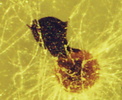Melanosporales
Ning ZhangIntroduction
The Melanosporales constitute a small order in the Hypocreomycetidae. Members of the Melanosporales have translucent perithecia and dark-colored ascospores. Most species in the Melanosporales are mycoparasites, fungi that are parasitic to other fungi. The Melanosporales had previously been considered to be part of the Hypocreales because of their soft, hyaline ascomata. The Melanosporales occur on rotting wood and herbaceous litter, and are frequently isolated from soil. Recent evidence suggested that Melanospora parasitizes soil borne pathogen such as Fusarium oxysporum and may be useful as a biological control agent (Harveson et al 2002).
Characteristics
The typical characteristics of the Melanosporales sensu Alexopoulos et al (1996) include translucent perithecial or cleistothecial ascomata, pseudoparenchymatous centra, absence of paraphyses in development, clavate evanescent asci, and dark colored ascospores. Anamorphs are hyphomycetous.
Discussion of Phylogenetic Relationships
The classification of the Melanosporialean fungi had been very conflicting due to the unique combination of their ecological and morphological features. They had been placed in the Hypocreales, Ceratostomataceae of the Sordariales, or Diaporthales . Previous phylogenetic studies based on rDNA sequences suggested that Melanospora is within or near Hypocreales (Spatafora and Blackwell 1994, Zhang and Blackwell 2002). When analyzed with more taxa of the Sordariomycetes, Melanospora formed a distinct clade outside Hypocreales (Castlebury et al 2004). A more recent study based on a four-gene phylogeny (Zhang et al 2006) supported the exclusion of Melanospora from the Hypocreales. Furthermore, a close relationship between the Coronophorales and the Melanosporales was recognized. Similar morphological and ecological features of the two orders include a pseudoparenchymatous ascomal wall, clavate, deliquescent asci, lack of paraphyses (with a few exceptions in the Coronophorales), and often a mycoparasitic habit.
References
Alexopoulos CJ, Mims CW, Blackwell M. 1996. Introductory Mycology. New York, USA: John Wiley & Sons, Inc.
Castlebury LA, Rossman AY, Sung G-H, Hyten AS, Spatafora JW. 2004. Multigene phylogeny reveals new lineage for Stachybotrys chartarum, the indoor air fungus. Mycol Res 108:864-872.
Harveson, RM, Kimbrough, JW, Hopkins, DL. 2002. Novel use of a pyrenomycetous mycoparasite for management of Fusarium wilt of watermelon. Pl Dis 86 : 1025-1030.
Hibbett, D. S., M. Binder, J. F. Bischoff, M. Blackwell, P. F. Cannon, O. E. Eriksson, S. Huhndorf, T. James, P. M. Kirk, R. Lücking, T. Lumbsch, F. Lutzoni, P. B. Matheny, D. J. Mclaughlin, M. J. Powell, S. Redhead, C. L. Schoch, J. W. Spatafora, J. A. Stalpers, R. Vilgalys, M. C. Aime, A. Aptroot, R. Bauer, D. Begerow, G. L. Benny, L. A. Castlebury, P. W. Crous, Y.-C. Dai, W. Gams, D. M. Geiser, G. W. Griffith, C. Gueidan, D. L. Hawksworth, G. Hestmark, K. Hosaka, R. A. Humber, K. Hyde, J. E. Ironside, U. Kõljalg, C. P. Kurtzman, K.-H. Larsson, R. Lichtwardt, J. Longcore, J. Miądlikowska, A. Miller, J.-M. Moncalvo, S. Mozley-Standridge, F. Oberwinkler, E. Parmasto, V. Reeb, J. D. Rogers, C. Roux, L. Ryvarden, J. P. Sampaio, A. Schüßler, J. Sugiyama, R. G. Thorn, L. Tibell, W. A. Untereiner, C. Walker, Z. Wang, A. Weir, M. Weiß, M. M. White, K. Winka, Y.-J. Yao, and N. Zhang. 2007. A higher-level phylogenetic classification of the Fungi. Mycological Research 111: 509-547.
Spatafora JW, Blackwell M. 1994. The polyphyletic origins of ophiostomatoid fungi. Mycol Res 98:1-9.
Vakili, NG. 1989. Gonatobotrys simplex and its teleomorph, Melanospora damnosa. Mycol Res 93 : 67-74
Zhang, N, Blackwell, M. 2002. Molecular phylogeny of Melanospora and similar pyrenomycetous fungi. Mycol Res 106: 148-155.
Zhang, N., Castlebury, L. A., Miller, A. N., Hundorf, S. M., Schoch, C., Seifert, K. A., Rossman, A. Y., Rogers, J. D., Kohlmeyer, J., Volkmann-Kohlmeyer, B, Sung, G-H. 2006. An overview of the systematics of the Sordariomycetes based on a four-gene phylogeny. Mycologia 98: 1077-1088.
Title Illustrations

Melanospora tiffanii perithecium with ascospores released from the ostiole.
| Scientific Name | Melanospora tiffanii |
|---|---|
| Comments | perithecium with ascospores released from the ostiole |
| Specimen Condition | Live Specimen |
| Collection | ATCC |
| Image Use |
 This media file is licensed under the Creative Commons Attribution-NonCommercial License - Version 2.5. This media file is licensed under the Creative Commons Attribution-NonCommercial License - Version 2.5.
|
| Copyright |
© Ning Zhang

|
About This Page
Ning Zhang

Rutgers University, Dept. of Plant Biology and Pathology
Correspondence regarding this page should be directed to Ning Zhang at
Page copyright © 2008 Ning Zhang
All Rights Reserved.
- First online 20 November 2007
- Content changed 20 November 2007
Citing this page:
Zhang, Ning. 2007. Melanosporales. Version 20 November 2007 (under construction). http://tolweb.org/Melanosporales/57149/2007.11.20 in The Tree of Life Web Project, http://tolweb.org/








 Go to quick links
Go to quick search
Go to navigation for this section of the ToL site
Go to detailed links for the ToL site
Go to quick links
Go to quick search
Go to navigation for this section of the ToL site
Go to detailed links for the ToL site